Power to the Opel - 1974 Opel Manta
The Manta should have made GM a sports sedan contender
09/23/2018
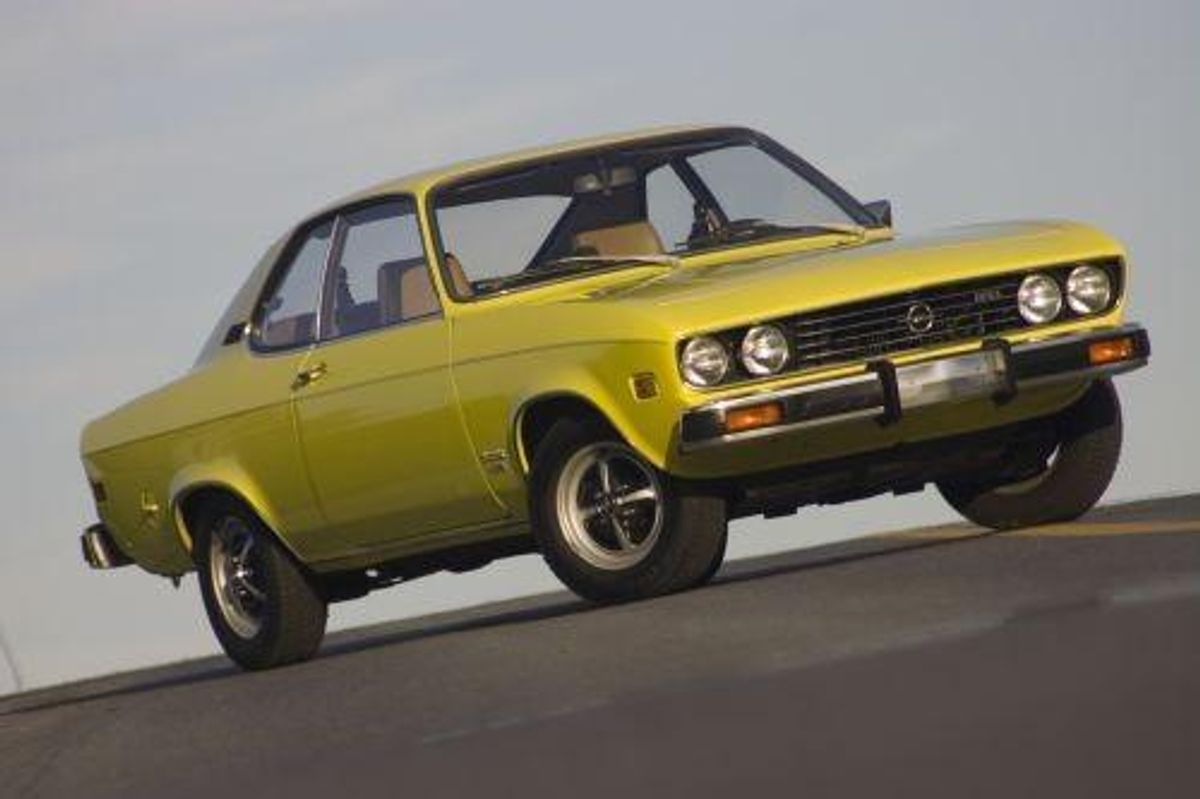

The BMW 320i has nothing on this thing, I'm shocked to admit as I'm running through the gears on Jim Ericson's 1974 Opel Manta. But it's easy to be misled with a quick seat-of-the-pants evaluation, on a car that you didn't expect much out of in the first place. But wow, it sure felt like it accelerated as fast, and held a corner almost as well, too.
It wasn't until I got back to the office and started running some comparison numbers that my initial thought proved to be at least partly true. In 1975, the Opel Manta 1900 offered zero to 60 numbers in the 11.6 to 13.5-second range, depending on which magazine you believed. The 1977 BMW 320i got there in 12.3. On a 100-foot radius skidpad, the BMW turned at 33 mph, with lateral acceleration of .726g, on a set of Michelin XVS 185/70HR13s. The Opel spun around at .665g on 165/13 bias-ply pizza cutters.

But when the Opel Manta was for sale in dealer showrooms, it got less respect than Rodney Dangerfield.
In 1974, the Manta in Luxus trim sold for $3,535. A 1976 Road & Track road test pegged the then-new 320i at an estimated test price of $9,000. But the Opel's price seemed to work against it as much as it did for it. Good comparison tests put it up against cars like the Ford Capri. Bad comparisons pitted the Manta against the Datsun B-210, the AMC Gremlin, the Honda Civic, the Ford Pinto, the Renault 12 and the Subaru 1400.
What may have hurt the Manta more than anything was the strength of the German mark versus the U.S. dollar. That discrepancy alone made prices climb $450 in 1975, more than 10 percent of the car's original sticker price. That happened to the other German imports, as well, but more established brands were able to absorb the cost more easily than Opel. It was, after all, a GM product, right? Why shouldn't an American consumer expect a price break on another GM brand?
And that's not to mention the sales program. In the early 1970s, when you thought "sexy Euro sports sedan," the Buick showroom probably wasn't where you'd think to look. Muscle cars may have brought a younger crowd into Buick showrooms in the late 1960s and early 1970s, but for the most part, Buick was a brand that catered to white-haired fedora-wearers more interested in being isolated from the road than having a connection with it.
Thirty years later, Opel is just now beginning to be recognized in America as a builder of excellent, mechanically durable and stylish small cars. Jim Ericson's is a 32,000-mile, rust-free example that is, in his words, "original in literally every department except the lug nuts." Ericson has no illusions about the car's performance as it sits today. "Though the car is pleasant to drive as is and corners very well, there is a lot of potential for upgrading."
Bob Legere knows a lot about squeezing that potential with upgrades, from simple bolt-ons, all the way to hot turbocharged setups. For the Opel owner who's interested in extracting more performance out of a street-driven Manta, Legere breaks the modifications into bolt-on and internal modification categories, all of which he has extensively detailed in several posts in the forums on OpelGT.com (see sidebar for specific web addresses).
But Legere's best piece of advice is this: "Having the parts is one thing, but getting it set up right is another," Legere says. "Most cars are not getting nearly 100 percent of their parts' capabilities, so setup is crucial. Consider having it dynoed on a chassis dyno. These days, $75 to $100 will get you six pulls on a dyno, and can tell you more about your setup than a month's worth of driving on the street. If you can get six to eight horsepower from tuning, then you just got more power than a Weber 38 DGAS carburetor is worth, and for a lot less money. Not to mention, you will get better gas mileage, and save money in the long run."
When the Manta was first sold in the United States in 1971, it was referred to by its engine displacement, simply the Opel 1900. The new 1.9-liter "cam-in-head" four was also the motivation for the new Opel sedans and station wagons, known familiarly under the 1900 name, but officially badged Ascona. The 1900 coupe was available in two forms: Standard and Rallye. Ericson's 1974 is the standard trim. Manta Rallyes were given a flat black hood treatment, a lower rear differential ratio, full gauges, tape stripes and foglamps.
That's pretty much the way the breakout worked for the following five model years. By 1973, the model became known as the Manta, and there were some minor changes throughout the years. In 1974, the slender chrome bumpers were replaced with larger, five-mile-per-hour bumpers that added a full five inches to the car's length and 150 pounds to its curb weight. Inside, a new pair of outboard dash vents moved a little air past the windows, and the auxiliary gauge set on Rallyes moved up a bit to be more readable. Models from 1975 are easily recognized by their Bosch L-Jetronic fuel-injection system, and the accompanying "Fuel Injection" emblem on the rear decklid.
The expectation set by the Manta's original--and its current--price is that it's going to be a thrashy little box, full of squeaks and rattles, and lacking in the performance department. Aside from lackluster acceleration--which can easily be rectified--we found the Manta an absolute pleasure to drive.
Steering in the Manta is unassisted, but you'd have to be Olive Oyl to need the help. The whole car, full of gas, only weighs on the order of 2,100 pounds, and the power assist would soften a lot of the feedback from the front tires. The Manta's suspension is where the comparison with the 320i gets interesting. The BMW featured decidedly unexotic MacPherson struts up front. Unlike the GT, with its transverse leaf spring front suspension, the Manta uses upper and lower A-arms and coil springs, and they do an admirable job keeping the front wheels in contact with the road.
The Manta's rear suspension is similarly exotic, especially for what was considered to be an economy car in the 1970s. The rigid rear axle is located by a three-link rear suspension, sprung by a set of coil springs, and improved by a Panhard bar and an anti-sway bar. In all, it's a great setup, and one that's remarkably easy to improve. "Basically, a set of shocks and better rubber could easily transform the Manta from a street car to a showroom stock contender," says Bob Legere.
And contend, the Manta did. Until 1975, when it was banned from SCCA competition, the Manta dominated its showroom stock class. Engine power wasn't up to the competition, but handling and aerodynamics made it absolutely unbeatable in those years. In period comparison road tests, the Manta came in second to last, but on the track it won every race it entered.
Sure, there's fake woodgrain and black plastic inside, and the elite turned up their noses at it circa 1974. But there's a lot of fake woodgrain and black plastic inside a 2002 or a 320i, too, only it came with a price tag nearly three times that of the Opel. Competing with the darkness of the dashboard, the front and rear seats in Ericson's Manta are tan, which results in a much more open feeling inside than pure black. The Manta seems to be made a lot more for comfort than it is for all-out speed, but more than 30 years after it was produced, we're not calling that a negative. With a reclining seat and plenty of adjustability in the tracks, it's easy to get yourself comfortable behind the wheel, no matter what your size. Jim Ericson is a lot taller than I am, and has no trouble at all adjusting the seat to optimal position.

We drive a lot of cars in this business, and we're supposed to maintain at least an arm's length when we write up our drive Reports. But I can't help telling you that the Manta suddenly rocketed to near the top of my list of "Must Owns." It has the perfect combination of driving character, exterior styling and overall usability that makes cars like the 320i so appealing. And its current price tag makes it even more so. The Manta is one of an ever-dwindling number of cars that offer a lot of fun, as well as an engaging community of enthusiasts who enjoy these cars precisely because of their thrifty nature, not only to drive, but to buy outright. "You're not going to make a lot of money in the Opel game," says Ericson. "The fun of Opels is having a cheap hobby to share with like-minded folks."
OPEL MANTA MODIFICATIONS
For the car hobbyist, the Internet has become an indispensable community. Ironically, Internet forums provide a connection that physical car clubs just can't seem to replicate. Members from all over the country can trade stories and information on a real-time basis, something that a monthly newsletter could never begin to provide.
The best source for vintage Opel information exists at www.OpelGT.com, which contains subforums on just about every possible facet of Opel collecting, restoring, modifying and driving.
Bob Legere is OpelGT.com's top poster, and has provided reams of information on modifying these cars and extracting the best, most usable performance from this simple engine. Here are a few of Bob's tips:
Bolt-On Performance:
www.opelgt.com/forums/engine-faqs/2305-looking-performance-ideas.html#post15975
Hot street engine, doubling rear wheel hp:
www.opelgt.com/forums/13287-post30.html
D-I-Y head porting:
www.opelgt.com/forums/opel-engine-performance-modifications/7426-street-porting-1-9-big-valve-head.html
A full turbo setup:
www.opelgt.com/forums/opel-engine-performance-modifications/3316-cih-turbo-efi-rallybob.html
Owner's Story
I got into Mantas in 1976 when my brother loaned me his 1971 1900. A year later I was 17 and bought my first, a five-year-old Rallye with 88K on the clock. I drove that car, packed to the roof with guitars, clothes, books, stereo, records and houseplants from Eugene, Oregon, to Chicago.
The car I found last year came tighter than the three I drove 20 years ago, a serendipitous find that needed only new fluids, belts and a little surface rust repair under the hood. The car inspires confidence and just sits down as you push it through turns, taking me back to some of the best years of my life. Modern Pirellis make it corner much better than designed. Finding my old car like new is better than nostalgia and very cheap for an obsession. When people look quizzically and ask, "Why an Opel?" I smile and start telling stories all over again.
-Jim Ericson
What to Pay
Low: $1,500
Average: $4,500
High: $8,000
Club Scene
The Classic Opel Community
www.opelgt.com
Opel Motorsports Club
www.opelclub.com
Pros & Cons
Pros
Sophisticated, class-winning suspension and aerodynamics
Inexpensive to purchase
An active online community
Cons
Watch for rust on a less than perfect example
Out-of-the-box engine performance is more economy-class
Restoration parts are hard to come by
1974 Opel Manta specs
ENGINE
Type: Inline four-cylinder, cast-iron block and head
Displacement: 1,900cc (115.8-cu.in.)
Bore x stroke: 93.0 x 69.8mm
Compression ratio: 7.6:1
Horsepower @ rpm: 90 @ 5,200
Torque @ rpm: 111-lbs.ft. @ 3,400
Main bearings: 5
Fuel system: Solex two-barrel carburetor
Lubrication system: Full pressure
Electrical system: 12-volts
Exhaust system: Single
TRANSMISSION
Type: Four-speed manual, all-synchro
Ratios: 1st 3.428:1
2nd: 2.156:1
3rd: 1.366:1
4th: 1.00:1
Reverse: 3.317:1
DIFFERENTIAL
Type: Open
Ratio: 3.44:1
STEERING
Type: Rack and Pinion
Ratio: 19.7:1
Turns, lock-to-lock: 3.8
Turning circle: 32.3 feet
BRAKES
Type: Power assist, front disc, rear cast-iron drum
Front: 9.4 inches
Rear: 9.1 x 2.0 inches
CHASSIS & BODY
Construction: Steel unibody
Body style: Four passenger, two door sedan
Layout Front: engine, rear-wheel drive
SUSPENSION
Front: Upper A-arms, lower transverse arms, coil springs, tube shocks, anti-roll bar
Rear: Live axle, upper and lower trailing arms, coil springs, tube shocks, Panhard rod
Wheels Steel: disc
Front/rear: 13 x 5.5 inches
Tires: Pirelli P4000
Front/rear: 185/70R 13
WEIGHTS & MEASURES
Wheelbase: 95.7 inches
Overall length: 171.0 inches
Overall width: 64.3 inches
Overall height: 53.3 inches
Front track: 52.4 inches
Rear track: 52.0 inches
Curb weight: 2,150 pounds
CAPACITIES
Crankcase: 2.9 quarts
Cooling system: 6.0 quarts
Fuel tank: 12 gallons
CALCULATED DATA
Bhp per cc: 4.74
Weight per bhp: 23.8 pounds
Weight per c.i.d.: 18.5 pounds
PERFORMANCE
0-60 mph: 10.5 seconds
¼ mile ET: 17.8 seconds @ 75.5 mph
Top speed: 105 mph
(Source: Car and Driver Road Test, March 1971)
PRICE
Base price: $3,267
The British motor industry is well represented on this week’s round up of successful sales on Hemmings.com. The strongest listing went to an LS V8-powered 1997 Land Rover Defender 110 custom that outperformed the market and looked to be able to well outperform a stock 110. A 1978 Aston Martin AM V8 found a new home via auction, the same fate experienced by a V12-powered 1972 Jaguar XKE Series 3 roadster. The original Jeep Grand Wagoneer was perhaps the first luxury SUV and the 1988 example sold on Hemmings.com featured low-mileage and excellent overall condition. There are few muscle cars are instantly recognizable as a Carousel Red Pontiac GTO Judge, like the 1969 model detailed below. Finally, we look at a restored 1913 Ford Model T Runabout sold from a Canadian-based collection.
For the week of May 12 through May 18, a total of 61 listings crossed the Hemmings Auctions block. Including Make Offer listings of previously ended auctions, a total of 40 cars were sold, resulting in a net 66% sell-through rate. An additional 29 cars were sold via direct Make Offer listings.
You can keep abreast of the latest consignments by subscribing to the daily Hemmings Auctions email newsletter.
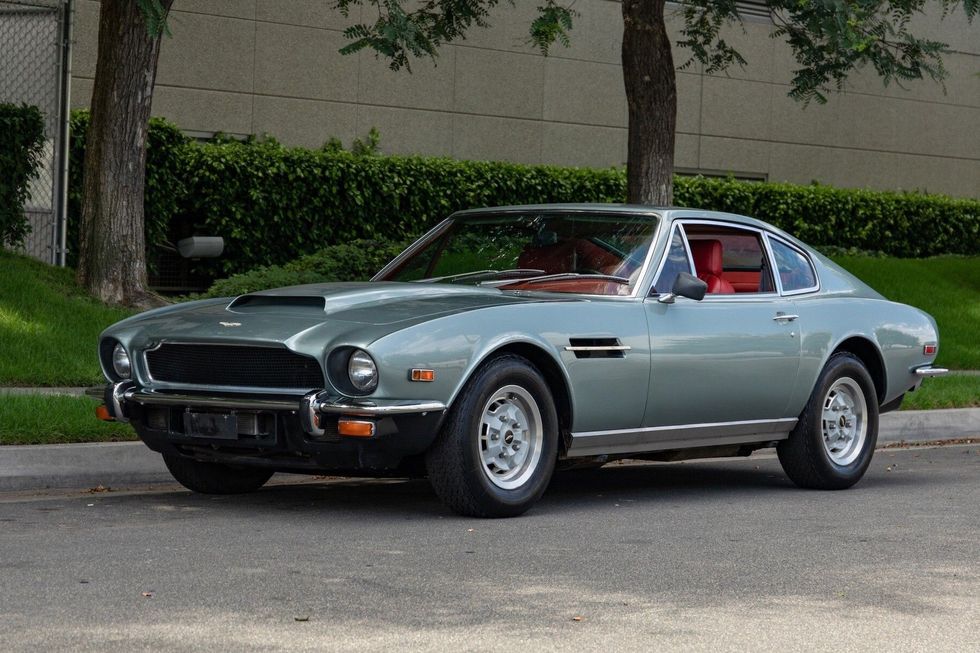
Reserve: $80,000
Selling Price: $84,000
Recent Market Range: $45,000-$80,000
Aston Martin produced some version of its V8-powered saloon from 1969 through 1989, though we are more likely to refer to the body style as a coupe on this side of the Atlantic. A beefy 5.3-liter DOHC V8 with multiple carburetors and a stout Chrysler-sourced TorqueFlite automatic very much gave the models a muscle car vibe, albeit one made with fine leather upholstery and thick wool carpets. This silver on red 1978 Aston Martin AM V8 Series III saloon, which traded hands last year via online auction for $46,988, achieved one of the highest prices seen in recent years for a coupe equipped with a standard-specification engine, particularly outside the U.K., where values are typically stronger.
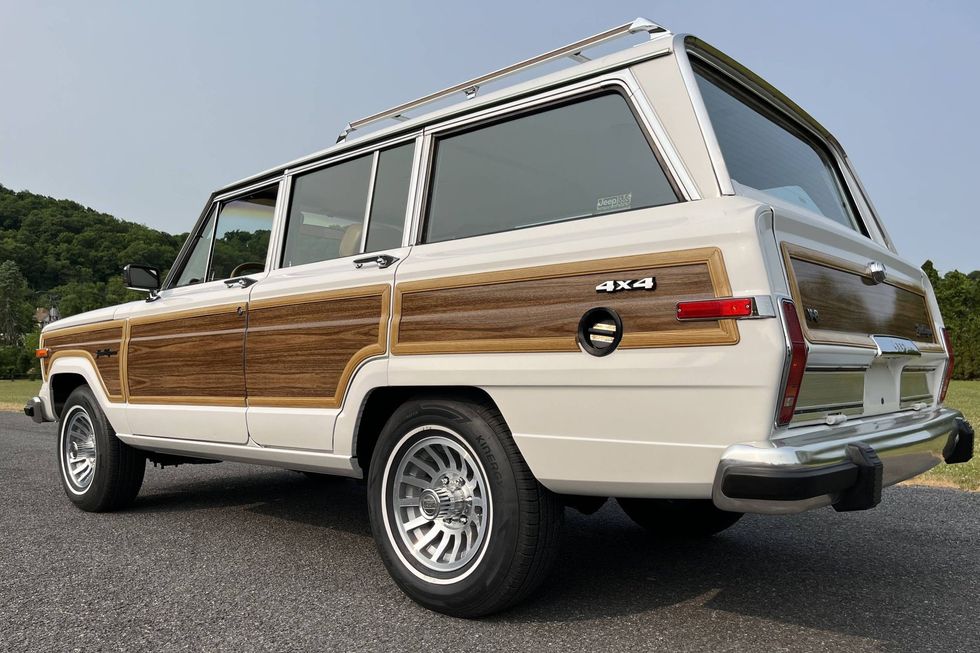
Reserve: $63,000
Selling Price: $68,775
Recent Market Range: $54,000-$75,000
Perhaps no other American vehicle has combined class and off-road capability quite like the original Grand Wagoneer, the trailblazing luxury SUV that was produced by Jeep for almost three decades. This 1988 Jeep Grand Wagoneer was submitted with just 27,417 miles showing on the odometer and plenty of notes from the seller indicating the original condition of the vehicle and all of its major components. The undercarriage, interior and engine bay photos all appeared to show an exceptionally clean example, which is notable for a rust-prone vehicle that has been in the Northeast since new. The net sale price, achieved with the 39th bid, was in line with market expectations for this very collectible vehicle.

Asking Price: $150,000
Selling Price: $157,500
Recent Market Range: $80,000-$150,000
The Land Rover Defender market shows no signs of slowing down, particularly as more and more examples are allowed into the U.S. via the DOT’s 25-year rule for previously banned imports. Likewise, there is a burgeoning market for what can best be described as restomodded examples, like this 1997 Land Rover Defender 110, which was powered by a modern GM LS3 V8, the same powerplant found in later C6 Corvettes. The list of what was original to this SUV might be shorter than what was changed, given the comprehensive nature of the build. Achieved via a direct Make Offer listing, the net sale price of this Land Rover was at the very top end of recent market activity for such customized Defenders.
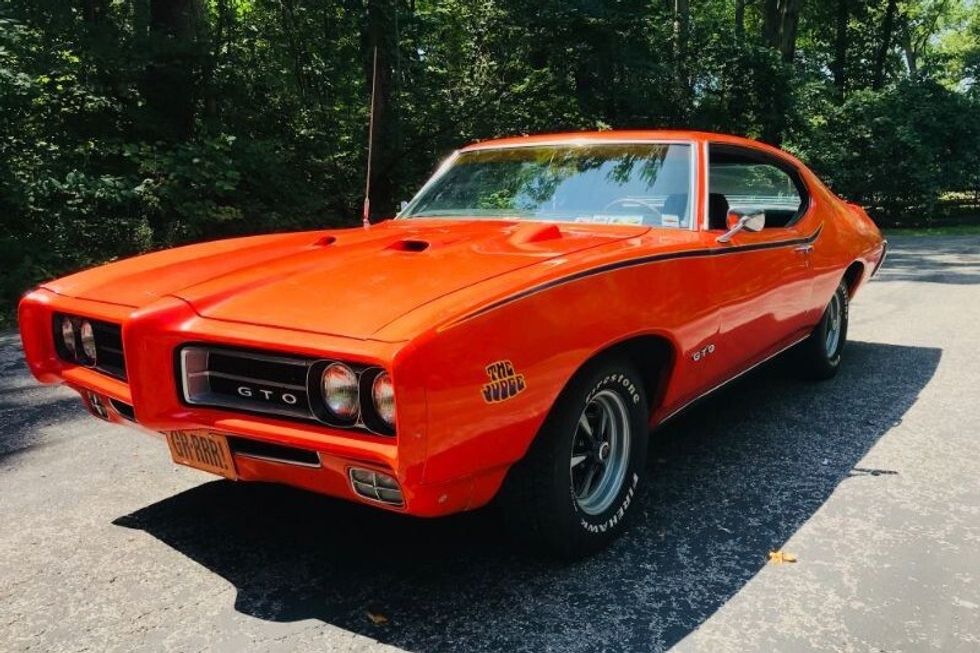
Reserve: $54,000
Selling Price: $52,500
Recent Market Range: $46,000-$62,000
This 1969 Pontiac GTO Judge ticked all the right boxes: matching numbers with photos verification of the partial VIN stamping on the engine block of the original Ram Air III V8, Muncie four-speed manual transmission, PHS documentation, and that classic Carousel Red finish and Judge decals. It looked to be in excellent overall condition, but it also appeared to have been driven and enjoyed some in recent years, with some signs of wear. And the net sale price, achieved via post-auction Make Offer listing, reflected the condition and authenticity of the car. A concours-level example, or one with a rare Ram Air IV engine for example, would likely command a premium over this one.
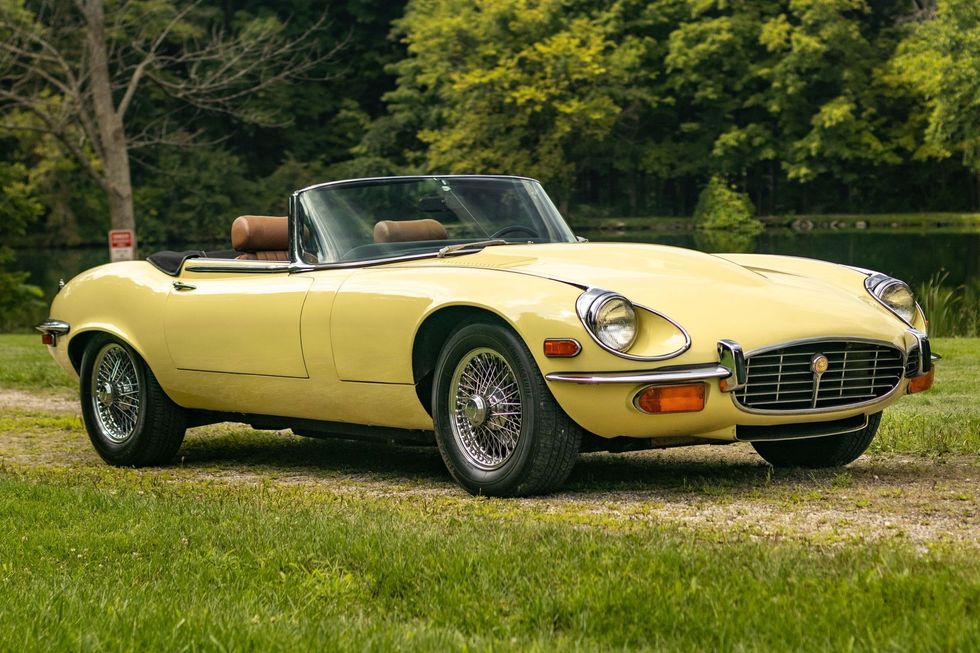
Reserve: $65,000
Selling Price: $69,825
Recent Market Range: $78,000-$115,000
The final iteration of the Jaguar XKE was a bit larger than the original and not as precisely focused on its sporting nature. Rather, with a big V12 under the hood, it was more of a GT car. This 1972 Jaguar E-type Series III Roadster appeared to have some minor wear and tear and signs of road use, but it made up for any shortcomings with what appeared to be an abundance of authenticity. The seller noted that the exterior finish, interior upholstery and engine were all original. Reflecting the low number of owners and the car’s years sitting in a museum, the odometer reading of just over 30,000 miles was also believed accurate. While the net sale price was below market expectations, it was not too far off.
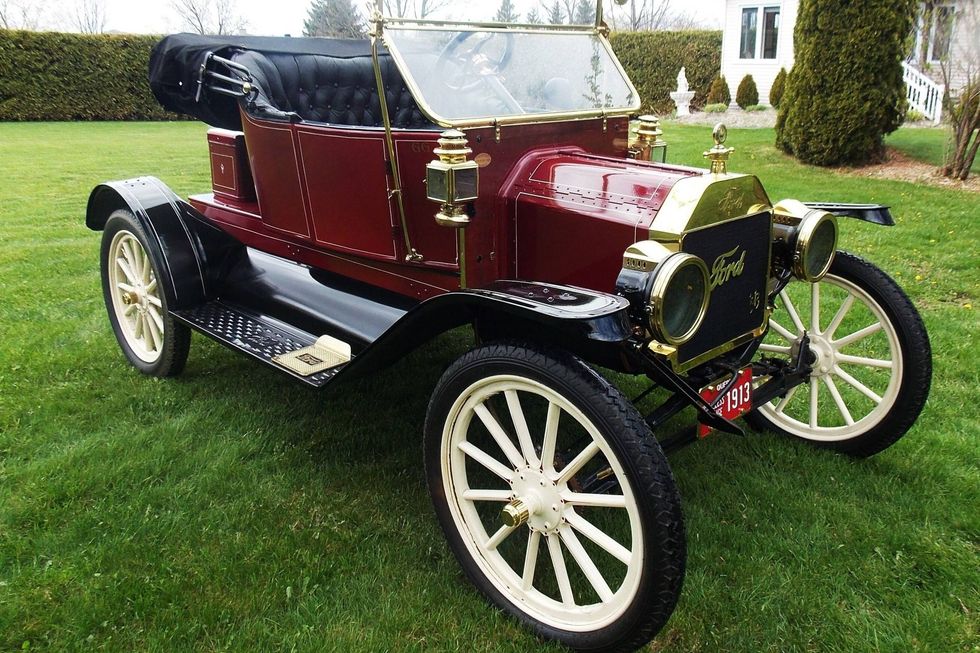
Reserve: $25,00
Selling Price: $26,250
Recent Market Range: $22,000-$36,000
There has never been a shortage of early Fords at Hemmings, dating to the earliest days of our magazine. Like any other vehicle, the most desired examples in the best condition will always attract the bidders. This 1913 Ford Model T Runabout appeared to have been restored to high level and showed only minimal signs of use. It was also equipped with an electric starter. The maroon body, black fenders and white spoke wheels nicely complemented the button-tufted black vinyl seat. The undercarriage appeared to be exceptionally clean, indicating little use for the car that was said to come from a Model T collection. The next sale price was well within the going market rate for an open-top, two-seat, early Model T.
What was thought to be the last Chevrolet Camaro rolled out of the factory in late-2023, but the model’s nameplate may not be on hiatus for long. General Motors president Mark Reuss reportedly wants to see the Camaro make a comeback as an affordable EV.
According to Motor Trend, Reuss has a vision to create a budget-friendly four-door electric vehicle under the Camaro muscle car nameplate. The approach would be somewhat similar to Ford’s Mach-E, except instead of offering an electric crossover alongside gas-powered coupe and convertible Mustangs, the Camaro would retain its sedan body style. The future electric Camaro is unlikely to be offered in a coupe or convertible version due to engineering complications for the EV platform and low sales numbers for two-door cars, which wouldn’t justify the extra expense.
While most Americans recognize the Camaro as a burly muscle car, Reuss reportedly wants the next generation of Camaro to go back to the model’s roots as a simple and affordable vehicle.
The estimated cost for a Camaro EV sedan could be similar to the current MSRP of a Chevy Equinox EV crossover which starts at $34,995. By adding an EV Camaro to its electric vehicle lineup, Chevrolet will have several affordable EVs available in the near future, including the return of the Chevy Bolt.
Despite Reuss’s desire to re-focus the Camaro EV on practicality and affordability instead of performance and high-horsepower numbers, it’s important to note that none of this news is formally part of GM’s production plan. With nothing yet set in stone, there’s still a glimmer of hope that we may still see a next-gen Camaro with bigger performance options.